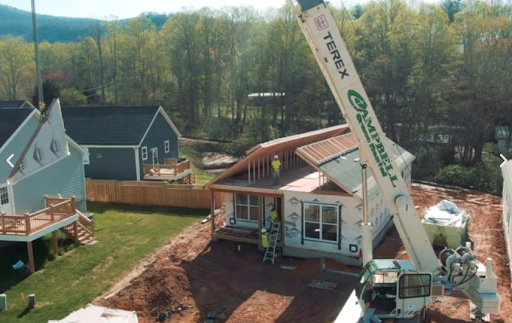
What is wrong with this picture?
1. The Crane There is a 120 Ton crane lifting a (very light) wall section. Obviously this was the same crane that lifted the home sections onto the foundation. They are using this oversized crane for this function just because it is already there, and because they need to use it for the rest of the day as they have to pay a one day minimum charge either way. The cost of a crane depends on how far it is from the site, but in any case, there is a one day minimum. A crane that size would cost between $4,000 - 8,000 per day. In comparison, a CAT5 home does not need a large crane as the Builder Module only weighs about 7,000 lbs, and the roof sections are light and can be easily lifted by a Lull (a ‘Telehandler’) that costs only about $600 per day to rent.
2. The Crawlspace Foundation Note the foundation that is under the Modular home. This foundation is built to frost depth, and the cost of a foundation like that averages about $15,000 - 22,000 in most regions. This is the approximate cost of the entire floor system in a CAT5 home, as it happens. However in a CAT5 home there is no need for a separate crawl space as the home is built on site with a concrete ‘slab on grade’ floor.
3. Modular Floor System Note the floor system in the modular home. This floor system is necessary in a factory built home in order to be able to transport the home, as no home can be transported with just walls and a roof. In a CAT5 home this entire floor system would be superfluous as there is already a floor poured with the foundation so that additional floor cost is not necessary.
4. Special Delivery Note the Modular sections have been delivered as two separate sections, each between 14 and 16ft wide. This is an oversized load delivery, and requires a special escort vehicle to accompany the home all the way from the factory, and some states require two separate escorts. In some states and regions one (or even two) of these escort cars has to be a police escort. As you can imagine these deliveries can be very expensive. An oversized delivery is between $8 - 10 per mile per section plus any extra expense for police escorts. The delivery of both sections can cost up to $20,000, but averages about $8,000. In contrast a Builder Module is only 12ft wide and can be delivered for between $1,000 - 3,000 anywhere in the country.
5. Site Access In addition to the delivery costs, if the home is not easily able to be placed onto the building pad on the buyer’s lot, and there are trees, fences, gates or power lines that must be moved, or a ditch in front of the home that must be filled (as there often is) then there is even more expense incurred there. In contrast a Builders Module is only 12ft wide, and can access almost any driveway and be easily maneuvered on site by the delivery truck.
6. The Specialty Set Crew Observe the crew working to assemble the home. A Modular home requires a specialty crew to place and assemble the home. Here you can see where they have already placed the home sections and have raised the roof sections. (Roof sections that are over 4/12 pitch require a special hinge hidden in the roof about half way up the roof down the entire length of the home BTW) These specialty crews set the home and generally charge between $5,000 - 10,000 just for their time to set the home and complete the roof and gable ends. In contrast, a CAT5 home does not require any specialty crews to set, as the Builder Module is small and easy to place and any capable handyperson with a helper can manage the lifting and setting of small roof sections with a telehandler and some basic instruction.
7. The Finish Crew What you can't see in this photo is the ‘Finish crew’. Once a home is set onto the foundation it is often necessary to hire a separate finish crew to come into the home to complete the finish of the marriage line where the two home sections come together. This requires trim, drywall and flooring finish as well as any outside items (soffit, fascia, siding of the gable ends etc) that the set crew did not do. This generally costs between $2,000 - 4,000 and can be much more on a larger home or a Modular with more than two sections. The CAT5 homes are finished and completed on site without a specialty set crew.
8. Modular Carrier Frame Also not shown in this photo is the ‘Mod Carrier’ - the transport frame that was used to deliver the home. There is always a deposit for the frame, and the cost to return the frame to the factory - which is on the dealer. That cost is generally between $1,500 - 4,000 depending how far the home came. Additionally, many Modular manufacturers are unable to locate enough transport frames for their homes so are now requiring that dealers purchase what is called a ‘Single Use Frame’. This adds up to $9,000 of upfront cost to the home, and the frame must also be scrapped by the dealer after delivery, which is another cost. (See attached bulletin from Champion about SUFs) In contrast, the (much smaller) carrier on a CAT5 Home is returned by the same truck that delivered the Builder Module on the same day at no additional cost.
The costs that are described here are all absolutely necessary in the delivery and installation of a Modular home but are not necessary in the building of a CAT5 home! They range between $35,000 - 50,000 and again, these costs do not apply to a CAT5 home built on site.
Consequently this is money that can be applied directly to the onsite installation costs of a CAT5 home, thus reducing the overall ‘per Sq Ft’ build cost and making the site built CAT5 home comparable in cost (and often less than!) the finished price of a Modular home.





